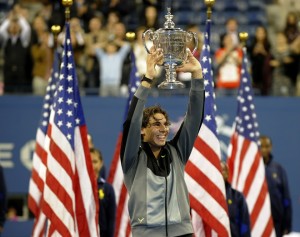He’ll never last. He plays too hard and his knees won’t hold up. Wrong.
He’s too young at 24 to win the career Grand Slam — titles at the Australian Open, French Open, Wimbledon and the U.S. Open. Wrong again, as of 10 p.m. Monday night.
He’ll never win the U.S. Open because the courts are too fast. Wrong again. And again and again.
You saw it. And if you didn’t. . .if you weren’t there to witness Rafa Nadal win his ninth major by 6-4, 5-7, 6-4, 6-2, you missed a momentous evening and more than three hours of power tennis and great shotmaking.

The match unfolded pretty much as I expected with Novak Djokovic playing very strong tennis through the first two sets. But when you play Nadal in a Grand Slam final, the match is seldom settled in the opening sets. If you’re going to beat Nadal, start fast, because he’s not often out-gutted in a four- or five-set match.
Right on form, midway through the third set Djokovic began to slow, just enough to give Nadal the edge he needed to take control. And then Nadal’s serve, which had been OK but not dominating in the early going, clicked in and he separated from his Serbian foe.
The final set was a rout with Djokovic playing riskier tennis, trying to end the points quicker and staying out of the long points that have a cumulative fatiguing effect on Nadal opponents.
And so Rafa at age 24 years and three months has his ninth Grand Slam title. Roger Federer won his ninth at age 25 years and one month. Could Nadal win three more majors by the time he reaches Federer’s birthday (Aug. 8).That would be a tough bet to take. But after what he’s done this year, why not.
He did it, and by doing so, educated a virtual army of doubters coming into this Slam.
* Remember “his knees won’t hold up?” He had effectively lost a year to tendonitis in 2009, beaten early at the French and unable to defend his Wimbledon title. But tendonitis is not a structural problem. It can be dealt with and Nadal and the team around him smartened up about how he practices and how often he plays.
He cut back his workouts, which became shorter but without any loss of intensity. After winning Monte Carlo this year, he decided not to play Barcelona — to rest his body. This could not have been an easy decision because Barcelona is the closest thing he has to a hometown tournament. But he did the right thing for his fitness.
After Wimbledon, he took three weeks off and played only the two ATP 1000s leading up to the U.S. Open — at Toronto and Cincinnati. He didn’t win either, leading some to believe that he wasn’t adequately ready for New York.
* Remember “he’s too young to win a career Grand Slam?” Why? You have to be a certain age to win it? He had already shown the world that he could go from clay court maven to grass court champion. How could you doubt his commitment to winning on any surface. The U.S. Open stadium court is faster than the stadium at the Aussie Open, but it’s still hardcourt tennis, and he had won the Australian. There was no reason why he couldn’t win the U.S. Open as well.
* Remember “the courts are too fast in New York?” Of all the reasons people gave why Nadal wouldn’t win the Open, that was the most confounding. The courts at the Open indeed are fast — probably the fastest of any ATP hardcourt tournament. But Nadal had won Wimbledon twice. Are the Open courts faster than Centre Court at Wimbledon?
He’s going to take a long rest after this one to recover both physically and emotionally and we’ll next see him somewhere indoors in Europe and then at the ATP Championships in November in London.
He came to New York as No. 1. He’ll leave as No. 1 and probably be No. 1 at the end of the year. If you didn’t realize tennis had moved into a new era with his second triumph at Wimbledon this year, you know it now.
